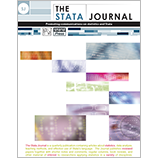baselinetable: A command for creating one- and two-way tables of summary statistics
Susan Donath
Clinical Epidemiology and Biostatistics Unit
Department of Paediatrics
University of Melbourne and
Murdoch Children's Research Institute
Royal Children's Hospital
Melbourne, Australia
[email protected]
|
Abstract. In this article, I describe baselinetable, a community-contributed
command for creating one- and two-way tables of summary statistics for a list
of numeric variables. Unlike other Stata tabulation commands such as tabulate,
table, or tabstat, the variables forming the table rows can be a mixture of continuous
(summarized by mean, standard deviation, etc.) and categorical (summarized
by percentages and frequencies). baselinetable provides considerable flexibility
in the way the results are displayed. In particular, the summary statistics and
their presentation can be different for each row variable. Additional features include
several options for displaying counts of missing and nonmissing data points
and the ability to restrict results to subgroups of the data for individual row variables.
The contents of the table can be saved as a data file or text file, or they
can be exported to Excel. The motivation for baselinetable is the descriptive
table commonly seen in health research publications in which the baseline characteristics
of two or more groups are compared. This descriptive table usually has
only one column for each group, generally with at least two summary statistics
in each column (for example, mean and standard deviation for continuous variables
or frequency and percentage for categorical variables). The baselinetable
command supports reproducible research by enabling researchers to easily create
tables whose contents can be used unchanged in publications.
View all articles by this author:
Susan Donath
View all articles with these keywords:
baselinetable, summary statistics table, health research tables
Download citation: BibTeX RIS
Download citation and abstract: BibTeX RIS
|
